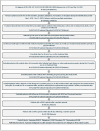Effectiveness and Safety in Patients with Non-Valvular Atrial Fibrillation Who Switched from Warfarin to Direct Oral Anticoagulants in Medicare Population
- PMID: 39883308
- PMCID: PMC11868198
- DOI: 10.1007/s12325-024-03099-y
Effectiveness and Safety in Patients with Non-Valvular Atrial Fibrillation Who Switched from Warfarin to Direct Oral Anticoagulants in Medicare Population
Abstract
Introduction: Atrial fibrillation (AF), a common heart rhythm abnormality, is linked to a higher risk of stroke. Traditionally, warfarin has been the primary anticoagulation treatment for reducing the stroke risk. The new standard of treatment by direct oral anticoagulants (DOACs) offers greater benefits including improved efficacy and fewer adverse effects with reduced monitoring. This study aims to evaluate the risk of stroke/systemic embolism (SE) and major bleeding (MB) among patients with AF who switched from warfarin to DOACs.
Methods: This study utilized Medicare data to conduct a retrospective analysis of patients with non-valvular atrial fibrillation (NVAF) who switched from warfarin to DOACs between January 1, 2012, and December 31, 2019. Patients with NVAF aged 65 and older who switched from warfarin and had continuous health plan enrollment were included. Descriptive statistics, propensity score matching (PSM), and Cox proportional hazard (PH) models were utilized to compare the outcomes and assess risks of SE and MB across the DOAC cohorts.
Results: Among 1,843,495 patients with NVAF on warfarin, 171,700 switched to DOACs within 90 days of discontinuation (apixaban: 90,850; rivaroxaban: 67,698; dabigatran: 12,900). The mean follow-up period across DOAC cohorts ranged from 552 to 628 days. After PSM, apixaban showed significantly lower rates of stroke/SE compared to dabigatran (2.99% vs. 3.98%, p < 0.0001) and rivaroxaban (3.08% vs. 3.80%, p < 0.0001). MB rates were also lower with apixaban versus dabigatran (4.29% vs. 5.57%, p < 0.0001) and rivaroxaban (4.07% vs. 6.35%, p < 0.0001). Cox PH models confirmed these findings, with apixaban demonstrating lower risks of stroke/SE [hazard ratio (HR) 0.83, 95% confidence interval (CI) 0.72-0.96 vs. dabigatran; HR 0.91, 95% CI 0.85-0.96 vs. rivaroxaban] and MB (HR 0.79, 95% CI 0.71-0.89 vs. dabigatran; HR 0.68, 95% CI 0.65-0.72 vs. rivaroxaban).
Conclusion: The risk of stroke/SE and MB varies significantly among patients with NVAF switching from warfarin to different DOACs, with apixaban presenting the lowest risk compared to dabigatran and rivaroxaban.
Keywords: Apixaban; Atrial fibrillation; Dabigatran; Direct oral anticoagulants; Rivaroxaban; Stroke; Switch; Systemic embolism; Warfarin.
© 2025. The Author(s).
Conflict of interest statement
Declarations. Conflict of Interest: Anandkumar Dubey, Amiee Kang, Jenny Jiang, and Dong Cheng are employees of BMS and may hold stock options. Nipun Atreja and Melissa Hagan were employees of BMS when the study was conducted. Nipun Atreja is currently affiliated with Immunovant. Melissa Hagan is currently affiliated with BeiGene. Abimbola Michael-Asalu is an employee of STATinMED. Steven Deitelzweig received research and consulting support from Pfizer and BMS. Ethical Approval: Since this study did not involve the collection, use, or transmittal of individually identifiable data, Institutional Review Board (IRB) approval was not required. This study only analyzed de-identified data which are a priori exempt from the Federal Policy for the Protection of Human Subjects (1991) and do not meet the identification criteria necessary to be privileged under the Health Insurance Portability and Accountability Act (HIPAA). Both the data and the security of the offices where the data were kept met HIPAA requirements. All authors had permission to access and use the database utilized in this study.
Figures



Similar articles
-
Effectiveness and safety in non-valvular atrial fibrillation patients switching from warfarin to direct oral anticoagulants in US healthcare claims.J Thromb Thrombolysis. 2024 Aug;57(6):1092-1102. doi: 10.1007/s11239-024-02976-1. Epub 2024 May 2. J Thromb Thrombolysis. 2024. PMID: 38698197 Free PMC article.
-
Comparative clinical outcomes between direct oral anticoagulants and warfarin among elderly patients with non-valvular atrial fibrillation in the CMS medicare population.J Thromb Thrombolysis. 2019 Aug;48(2):240-249. doi: 10.1007/s11239-019-01838-5. J Thromb Thrombolysis. 2019. PMID: 30924051 Free PMC article.
-
Effectiveness and safety of direct oral anticoagulants compared to warfarin in treatment naïve non-valvular atrial fibrillation patients in the US Department of defense population.BMC Cardiovasc Disord. 2019 Jun 13;19(1):142. doi: 10.1186/s12872-019-1116-1. BMC Cardiovasc Disord. 2019. PMID: 31195999 Free PMC article.
-
Direct comparative effectiveness and safety between non-vitamin K antagonist oral anticoagulants for stroke prevention in nonvalvular atrial fibrillation: a systematic review and meta-analysis of observational studies.Eur J Epidemiol. 2019 Feb;34(2):173-190. doi: 10.1007/s10654-018-0415-7. Epub 2018 Jun 8. Eur J Epidemiol. 2019. PMID: 29948370
-
An indirect comparison of dabigatran, rivaroxaban and apixaban for atrial fibrillation.Thromb Haemost. 2012 Sep;108(3):476-84. doi: 10.1160/TH12-02-0093. Epub 2012 Jun 28. Thromb Haemost. 2012. PMID: 22740145 Review.
Cited by
-
Demographic and Socio-Economic Disparities in the Outcomes Among Patients with NVAF Treated with Oral Anticoagulants: A Real-World Evaluation of Medicare Beneficiaries.J Clin Med. 2025 May 7;14(9):3252. doi: 10.3390/jcm14093252. J Clin Med. 2025. PMID: 40364283 Free PMC article.
-
Exploring Internal Medicine by a Comparative Schematic Analysis of the Long-Term Outcomes of Anticoagulation Therapy in Atrial Fibrillation.Cureus. 2025 Apr 17;17(4):e82475. doi: 10.7759/cureus.82475. eCollection 2025 Apr. Cureus. 2025. PMID: 40385913 Free PMC article. Review.
References
-
- Patel MR, Mahaffey KW, Garg J, Pan G, Singer DE, Hacke W, et al. Rivaroxaban versus warfarin in nonvalvular atrial fibrillation. N Engl J Med. 2011;365(10):883–91. - PubMed
-
- Healthline. What is nonvalvular atrial fibrillation? 2023 [updated 5/19/2023. Available from: https://www.healthline.com/health/atrial-fibrillation/nonvalvular.
-
- Molteni M, Polo Friz H, Primitz L, Marano G, Boracchi P, Cimminiello C. The definition of valvular and non-valvular atrial fibrillation: results of a physicians’ survey. Europace. 2014;16(12):1720–5. - PubMed
MeSH terms
Substances
LinkOut - more resources
Full Text Sources
Medical
Miscellaneous

